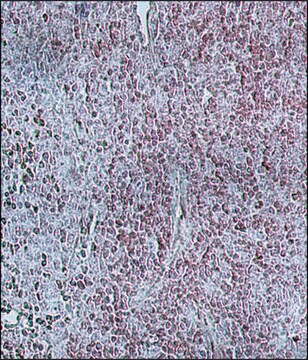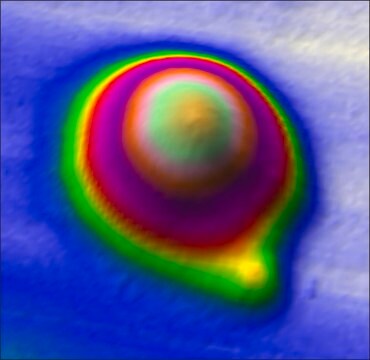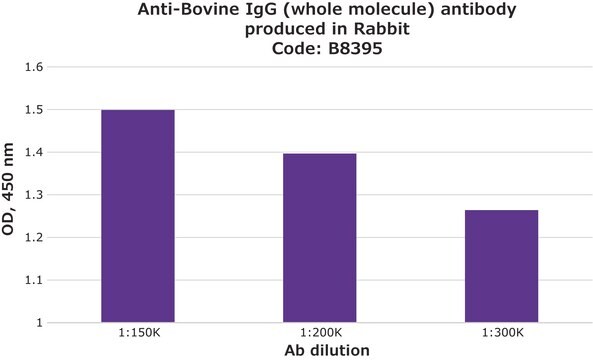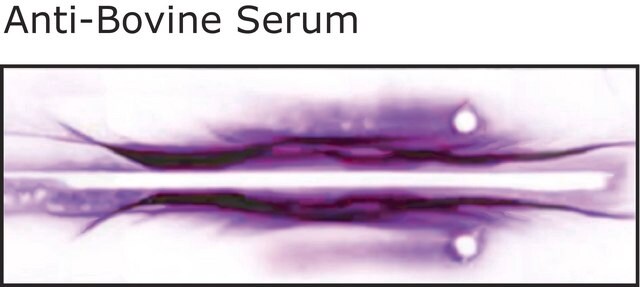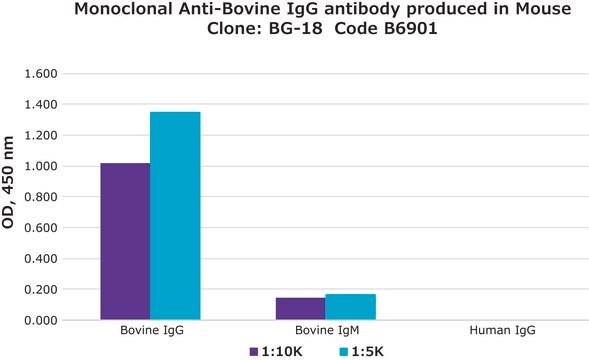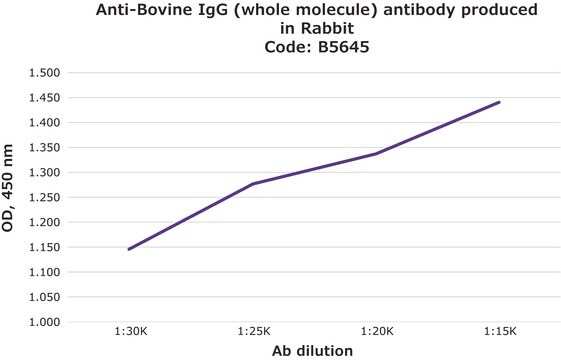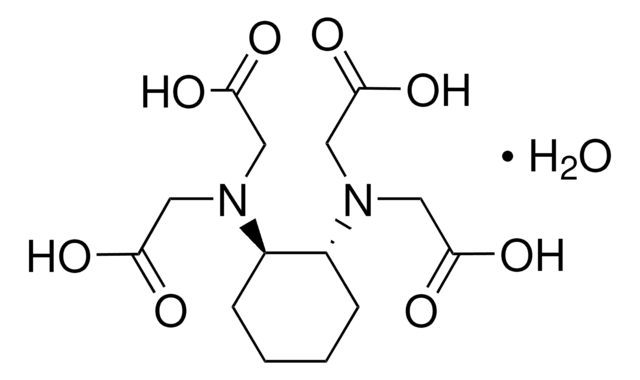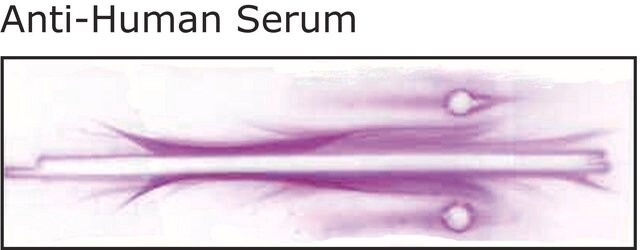B1645
Anti-Bovine IgG (whole molecule) antibody produced in goat
whole antiserum
Se connecterpour consulter vos tarifs contractuels et ceux de votre entreprise/organisme
About This Item
Produits recommandés
Source biologique
goat
Niveau de qualité
Conjugué
unconjugated
Forme d'anticorps
whole antiserum
Type de produit anticorps
secondary antibodies
Clone
polyclonal
Contient
15 mM sodium azide
Technique(s)
quantitative precipitin assay: 2.8 mg/mL
Conditions d'expédition
dry ice
Température de stockage
−20°C
Modification post-traductionnelle de la cible
unmodified
Description générale
IgG antibody subtype is the most abundant of serum immunoglobulins of the immune system. It is secreted by B cells and is found in blood and extracellular fluids.
Spécificité
The antiserum shows a single arc of precipitation versus bovine serum and bovine IgG by immunoelectrophoresis (IEP). This antiserum has not been assayed for interspecies cross reactivity.
Application
Anti-Bovine IgG (whole molecule) antibody produced in goat has been used in:
- quantitative precipitation assays and in various immunosensor methods to detect bovine IgG in serum and milk
- immuno-reaction assay
- indirect sandwich enzyme linked immunosorbent assay (ELISA)
It has also been used in immuno-reaction assay.
Actions biochimiques/physiologiques
IgG antibody subtype is the most abundant of serum immunoglobulins of the immune system. It is secreted by B cells and is found in blood and extracellular fluids and provides protection from infections caused by bacteria, fungi and viruses. Maternal IgG is transferred to fetus through the placenta that is vital for immune defense of the neonate against infections.
Forme physique
Supplied as a liquid with 0.1% sodium azide (see MSDS) as a preservative.
Notes préparatoires
treated to remove lipoproteins
Stockage et stabilité
For continuous use, store at 0-5 °C. For extended storage, solution may be frozen in working aliquots. Repeated freezing and thawing is not recommended. Storage in "frost-free" is not recommended. If slight turbidity occurs upon prolonged storage, clarify by centrifugation before use.
Clause de non-responsabilité
Unless otherwise stated in our catalog or other company documentation accompanying the product(s), our products are intended for research use only and are not to be used for any other purpose, which includes but is not limited to, unauthorized commercial uses, in vitro diagnostic uses, ex vivo or in vivo therapeutic uses or any type of consumption or application to humans or animals.
Vous ne trouvez pas le bon produit ?
Essayez notre Outil de sélection de produits.
Code de la classe de stockage
10 - Combustible liquids
Classe de danger pour l'eau (WGK)
nwg
Point d'éclair (°F)
Not applicable
Point d'éclair (°C)
Not applicable
Faites votre choix parmi les versions les plus récentes :
Déjà en possession de ce produit ?
Retrouvez la documentation relative aux produits que vous avez récemment achetés dans la Bibliothèque de documents.
Les clients ont également consulté
Mauro Tomassetti et al.
Journal of pharmaceutical and biomedical analysis, 73, 90-98 (2012-05-09)
Within the framework of research carried out by our team aimed at developing new immunological methods to determine proteins such as immunoglobulins G in different biological matrixes, for instance, serum and milk, tests were performed on several immunosensors based on
Bismuth film electrode as sensing platform for IgE-anti-IgE interactions
Anik U, et al.
Electroanalysis, 23(10), 2379-2385 (2011)
IL-21-induced isotype switching to IgG and IgA by human naive B cells is differentially regulated by IL-4
Avery DT, et al.
Journal of Immunology, 181(3), 1767-1779 (2008)
Placental transfer of IgG subclasses in a Japanese population.
Hashira S, et al.
Pediatrics International, 42(4) (2000)
Gestur Vidarsson et al.
Frontiers in immunology, 5, 520-520 (2014-11-05)
Of the five immunoglobulin isotypes, immunoglobulin G (IgG) is most abundant in human serum. The four subclasses, IgG1, IgG2, IgG3, and IgG4, which are highly conserved, differ in their constant region, particularly in their hinges and upper CH2 domains. These
Notre équipe de scientifiques dispose d'une expérience dans tous les secteurs de la recherche, notamment en sciences de la vie, science des matériaux, synthèse chimique, chromatographie, analyse et dans de nombreux autres domaines..
Contacter notre Service technique